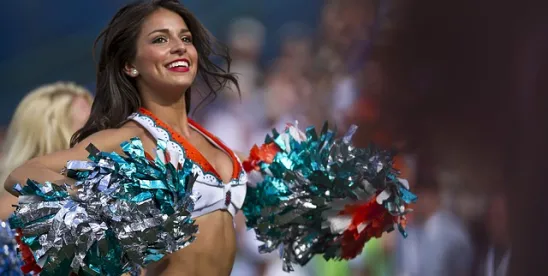In a decision that clarifies one controversial aspect of copyright and fashion law, the U.S. Supreme Court recently ruled that certain design elements of cheerleader uniforms may be eligible for copyright protection.[1] The Supreme Court held that, under § 101 of the Copyright Act, “a feature incorporated into the design of a useful article is eligible for copyright protection only if the feature (1) can be perceived as a two- or three-dimensional work of art separate from the useful article and (2) would qualify as a protectable pictorial, graphic, or sculptural work — either on its own or fixed in some other tangible medium of expression — if it were imagined separately from the useful article into which it is incorporated.”[2] Justice Clarence Thomas authored the 6–2 majority opinion, addressing disagreement among lower courts as to the proper test for determining if certain design elements could ever qualify for copyright protection. Justice Ruth Bader Ginsburg concurred in the judgment, and Justices Stephen Breyer and Anthony Kennedy dissented.
Case Background
Fashion design receives only limited protection under the Copyright Act, which states that “useful articles” with “an intrinsic utilitarian function” are generally not copyrightable.[3] Section 101 of the Copyright Act provides protection for certain aspects of design only where “such design incorporates pictorial, graphic, or sculptural features that can be identified separately from, and are capable of existing independently of, the utilitarian aspects of the article.”[4]
Varsity Brands, Inc. (“Varsity”) designs and produces cheerleading uniforms. Varsity has accumulated “more than 200 U.S. copyright registrations for two-dimensional designs appearing on the surface of their uniforms and other garments.”[5] Varsity sued Star Athletica, L.L.C. (“Star Athletica”), another producer of cheerleader uniforms, for infringing Varsity’s copyrights in five designs. The designs at issue were “arrangements of elements” such as chevrons, lines, curves, stripes, angles, and diagonals. The trial court awarded Star Athletica summary judgment, ruling that Varsity’s designs did not qualify for copyright protection because they served the utilitarian function of identifying the garments as cheerleading uniforms and were not “physically or conceptually” separable from the useful function of the uniform under § 101 of the Copyright Act.
On appeal, the Sixth Circuit reversed. A 2–1 majority explained that the graphic designs at issue were “separately identifiable” because the designs “and a blank cheerleading uniform can appear ‘side by side.’” Because the two-dimensional pictorial and graphic designs were “capable of existing independently” from their placement on the uniform, they were found eligible for protection. The dissent agreed with the district court that the designs merely functioned to identify the wearer as a cheerleader and were not conceptually separable.[6]
Conceptual Disarray
Each of the Supreme Court’s majority, concurring, and dissenting opinions acknowledged the confusion and disagreement over the proper test for copyright protection of design elements in useful articles. The dissent in the Sixth Circuit characterized this area of law as “a mess.” Indeed, the Sixth Circuit identified nine different tests and hybrids that various courts and the U.S. Copyright Office had employed over the years to address “separability.” Justice Ginsburg’s Supreme Court concurrence also noted, “[c]ourts have struggled mightily to formulate a test” for separability analysis.[7]
Majority Opinion
To resolve this confusion, the majority opinion crafted an approach rooted in the text of § 101 of the Copyright Act. Justice Thomas noted at the outset that the Supreme Court’s task “is not a free-ranging search for the best copyright policy, but rather depends solely on statutory interpretation.”[8]
First, the Supreme Court did not agree with Varsity’s contention that two-dimensional designs on useful articles are “inherently separable,” stating that such an approach conflicts with the text of § 101. Rather, the Supreme Court explained, separability analysis is required for two-dimensional designs because the statute covers any “pictorial, graphic, or sculptural features incorporated into the design of a useful article.”[9]
The Supreme Court stated that § 101 enumerates two requirements for copyright protection of design elements incorporated into useful articles: (1) separate identification; and (2) independent existence. For a design element of a useful article to be copyrightable, the decision-maker must first look to the useful article and identify “some two- or three-dimensional element that appears to have pictorial, graphic or sculptural qualities.” Next, the decision-maker “must determine that the separately identified feature has the capacity to exist apart from the utilitarian aspects of the article.”[10]
The Supreme Court held that both § 101 and § 113(a) of the Copyright Act “make clear that copyright protection extends to pictorial, graphic, and sculptural works regardless of whether they were created as freestanding art or as features of useful articles.” Thus, the ultimate separability question is whether a design feature would have been eligible for copyright protection if it had been originally fixed in a tangible medium other than a useful article before being applied to a useful article. The Supreme Court’s approach requires the determination of whether a pictorial, graphic, or sculptural design feature can be imagined “apart from the useful article.”[11]
Applying this approach to the facts at issue, the Supreme Court first found that the colors, shapes, stripes, and chevrons on the uniforms could be identified as having pictorial, graphic, or sculptural qualities. Second, the design elements could be imaginatively separated and applied in another medium (e.g., a painter’s canvas). Thus, the two-dimensional works of art fixed in the uniform fabric met both the separate-identification and independent-existence requirements of the statute.
The Supreme Court rejected various alternative approaches advanced by Star Athletica and the U.S. government through its amicus brief. First, the Supreme Court rejected the contention that a feature exists independently “only if it can stand alone as a copyrightable work and if the useful article from which it was extracted would remain equally [or similarly] useful.”[12] The Supreme Court found no basis for such an interpretation in the statute and stated that the focus is on the separability of the feature itself, not on what remains of the useful article after the feature is imaginatively extracted. In other words, “the statute does not require the decisionmaker to imagine a fully functioning useful article without the artistic feature.”[13] Therefore, it was not necessary to analyze the usefulness of a plain white cheerleading uniform. In so holding, the Supreme Court expressly abandoned the distinction between “physical” and “conceptual” separability that some courts (notably the Second Circuit Court of Appeals) and commentators had adopted.[14]
The Supreme Court next rejected Star Athletica’s arguments that the test for separability should include the two “objective” components: (1) whether the design feature reflects artistic judgment independent of functional influence; and (2) whether there is a substantial likelihood the feature would be marketable to the community without its utilitarian function.[15] The Supreme Court stated that neither of these considerations is grounded in the text of the statute. Rather, the inquiry is limited “to how the article and feature are perceived, not how or why they were designed.”[16] Similarly, nothing in the statute requires recourse to market surveys: “[A]sking whether some segment of the market would be interested in a given work threatens to prize popular art over other forms, or to substitute judicial aesthetic preferences.”[17]
Finally, the Supreme Court dispensed with Star Athletica’s assertion that allowing surface decorations to qualify as original works of authorship is inconsistent with Congress’s intent to exclude industrial design from copyright and instead channel such activity into design patents. Congress has afforded copyright eligibility to certain useful articles like semiconductor chips and boat hulls but has refused to pass a provision protecting industrial design. The Supreme Court stated, however, that Congress’s inaction holds little weight and that design patent and copyright are not mutually exclusive.
Importantly, the Supreme Court held only that the designs are eligible for protection; now the trial court must determine whether Varsity’s specific lines, chevrons, and shapes are original enough to merit copyright protection. Even if the decorative elements obtain protection, the copyright can only extend to the two-dimensional work of art fixed in the fabric. Protection will not cover the uniform design generally. Varsity will not be able prevent the reproduction of uniforms of “identical shape, cut, and dimensions.”[18]
Concurrence
Justice Ginsburg concurred in the result but stated that it was not necessary to address separability because the designs at issue were not designs of useful articles but were rather standalone pictorial and graphic works that Varsity reproduced on useful articles such as cheerleading uniforms and other garments. The majority declined to address this approach because Varsity had not advanced it. Justice Ginsburg felt that Varsity’s brief adequately supported her approach.[19] Like the majority, Justice Ginsburg explicitly did not address whether the designs at issue met the requirements for copyrightable subject matter, although she noted, “the requisite level of creativity [for copyrightability] is extremely low; even a slight amount will suffice.”[20]
Dissent
Justice Breyer, joined by Justice Kennedy, dissented, arguing that application of the majority’s test yields the opposite result, because the designs at issue cannot be perceived separately without replicating the cut and style of the cheerleading uniforms. Justice Breyer agreed with the much of the majority opinion, including the majority’s statement that “one may not ‘claim a copyright in a useful article merely by creating a replica of that article in some other medium,’ which ‘would not give rise to any rights in the useful article that inspired it.’”[21] Breyer criticized the majority, however, for imagining that Varsity submitted only surface decorations of chevrons and stripes “like swaths from a bolt of fabric.”[22] Justice Breyer stated that such simple stripes are plainly unoriginal when considered on their own and argued that Varsity cannot claim ownership of the particular “treatment and arrangement” of the chevrons and lines of the design as they appear in each cheerleading uniform.
Breyer noted that although Congress repeatedly has declined to extend broad copyright protection to fashion designs, the $370 billion U.S. fashion industry has thrived against a backdrop that allows it to seek protection through design patents, trademarks, and copyrights of original designs applied to fabric before it is cut.[23]
Implications for the Fashion Industry and Beyond
The majority’s opinion clarifies the proper approach to separability, but the dissent demonstrates that application of that test may yield divergent results. In declining to announce a bright-line rule against the registerability of design elements on garments, and in declining to hold that two-dimensional designs on useful articles are “inherently separable,” the Supreme Court largely maintained the status quo. The decision is likely to be embraced by fashion industry leaders and other garment design stakeholders for its recognition that certain garment design elements may be protectable under the Copyright Act. While fabric design per se is undoubtedly eligible for copyright protection, it is clear now that other dress and clothing design elements, such as all manner of appliqués, as well as patterns of buckles, beads, jewels, sequins, lace, and other trimmings, also will be protectable if they pass this newly stated test. As to Varsity’s design elements, the trial court now will need to decide whether Varsity’s designs meet the relatively low threshold of originality to warrant copyright protection.
[1] Star Athletica, L.L.C. v. Varsity Brands, Inc., No. 15-866 (U.S. Mar. 22, 2017).
[2] Slip op. at 1–2.
[3] 17 U.S.C. § 101.
[4] Id.
[5] No. 15-866, slip op. at 2.
[6] Id. at 2–3.
[7] Id. at 1, n.1 (Ginsburg, J., concurring).
[8] Id. at6 (majority opinion) (quotation marks omitted).
[9] Id. at 5 (quotation marks omitted).
[10] Id. at 7.
[11] Id. at 8.
[12] Id. (emphasis in original).
[13] Id.
[14] See Chosun Int’l, Inc. v. Chrisha Creations, Ltd., 413 F.3d 324, 329 (2d Cir. 2005).
[15] No. 15-866, slip op. at 8.
[16] Id.
[17] Id.
[18] Id. at 12.
[19] Id. at 3 (Ginsburg, J., concurring) (citing Brief for Respondents at 25 (explaining that the Copyright Act “expressly provides that pictorial, graphic or sculptural designs do not lose their protection when they appear ‘in or on’ a useful article”); Brief for Respondents at 52 (disclaiming the need for separability analysis because the designs are themselves pictorial, graphic, or sculptural works)).
[20] Id. at 1 (quoting Feist Publications, Inc. v. Rural Telephone Service Co., 499 U.S. 340, 345 (1991)).
[21] Id. at 9 (Breyer, J., dissenting) (quoting Thomas, J., majority at 7–8).
[22] Id. at 11.
[23] Id. at 9 (citing Brief for Counsel of Fashion Designers of America, Inc., as amicus curiae at 3–4).






 />i
/>i
